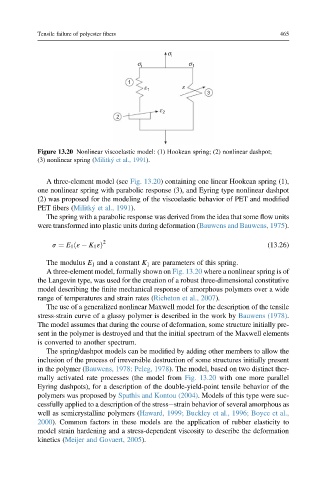Page 492 - Handbook of Properties of Textile and Technical Fibres
P. 492
Tensile failure of polyester fibers 465
σ l
σ i σ 1
1
ε
ε 1
3
ε 2
2
Figure 13.20 Nonlinear viscoelastic model: (1) Hookean spring; (2) nonlinear dashpot;
(3) nonlinear spring (Militký et al., 1991).
A three-element model (see Fig. 13.20) containing one linear Hookean spring (1),
one nonlinear spring with parabolic response (3), and Eyring type nonlinear dashpot
(2) was proposed for the modeling of the viscoelastic behavior of PET and modified
PET fibers (Militký et al., 1991).
The spring with a parabolic response was derived from the idea that some flow units
were transformed into plastic units during deformation (Bauwens and Bauwens, 1975).
2
s ¼ E 1 ðε K 1 εÞ (13.26)
The modulus E 1 and a constant K 1 are parameters of this spring.
A three-element model, formally shown on Fig. 13.20 where a nonlinear spring is of
the Langevin type, was used for the creation of a robust three-dimensional constitutive
model describing the finite mechanical response of amorphous polymers over a wide
range of temperatures and strain rates (Richeton et al., 2007).
The use of a generalized nonlinear Maxwell model for the description of the tensile
stress-strain curve of a glassy polymer is described in the work by Bauwens (1978).
The model assumes that during the course of deformation, some structure initially pre-
sent in the polymer is destroyed and that the initial spectrum of the Maxwell elements
is converted to another spectrum.
The spring/dashpot models can be modified by adding other members to allow the
inclusion of the process of irreversible destruction of some structures initially present
in the polymer (Bauwens, 1978; Peleg, 1978). The model, based on two distinct ther-
mally activated rate processes (the model from Fig. 13.20 with one more parallel
Eyring dashpots), for a description of the double-yield-point tensile behavior of the
polymers was proposed by Spathis and Kontou (2004). Models of this type were suc-
cessfully applied to a description of the stressestrain behavior of several amorphous as
well as semicrystalline polymers (Haward, 1999; Buckley et al., 1996; Boyce et al.,
2000). Common factors in these models are the application of rubber elasticity to
model strain hardening and a stress-dependent viscosity to describe the deformation
kinetics (Meijer and Govaert, 2005).

